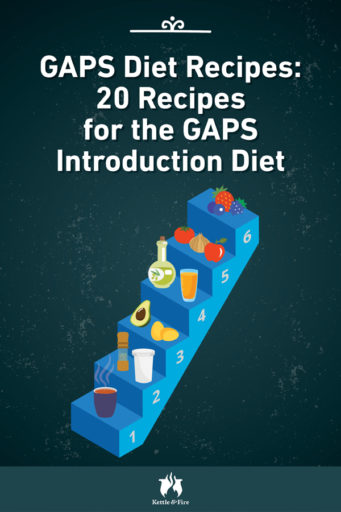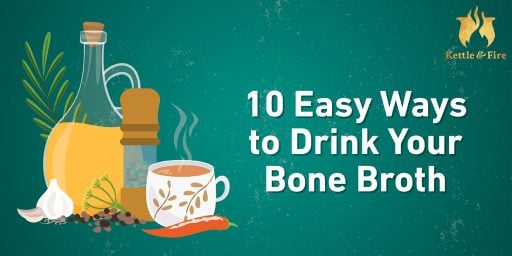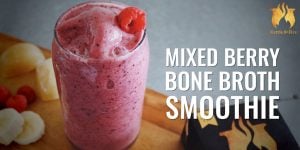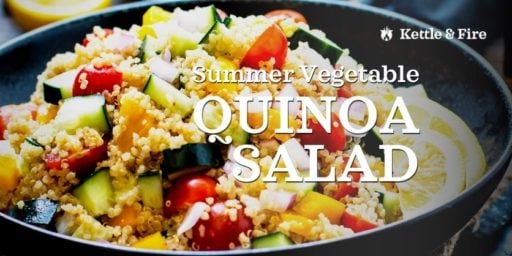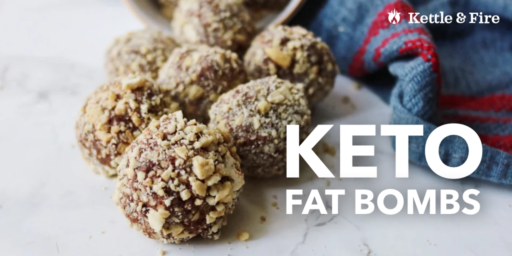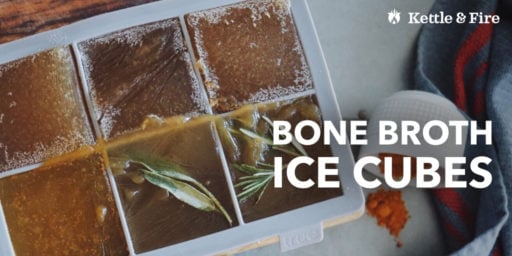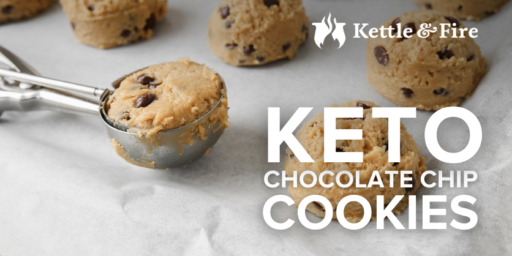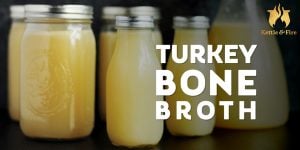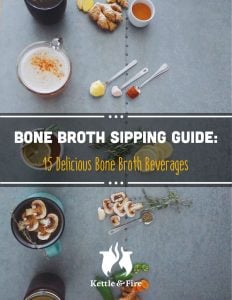GAPS Diet Recipes: 20 Recipes for the GAPS Introduction Diet

If you’re just starting the GAPS diet, you know what lies ahead: cutting out entire food groups and slowly reintroducing them one-by-one. The first phase of GAPS — referred to as the GAPS introduction diet — is viewed as one of the strictest elimination diets in existence.
The first phase of the introduction diet includes only homemade stocks and probiotics. From there, you’ll slowly add in cooked meats, cooked vegetables, and eventually reintroduce raw vegetables and fruits in the sixth and final phase.
This might leave you wondering, “What can I eat?” Rest assured — below, you’ll learn exactly what to eat throughout all six phases of the GAPS intro diet, and 20 recipes you can include in your meal plan.
What Is the GAPS Diet?
The GAPS diet (Gut and Psychology Syndrome) is an elimination diet focused on the connection between the gut and the brain. The founder, Dr. Natasha Campbell-McBride, developed the diet after working with hundreds of adult and child cases of digestive disorders and neurological disorders.
The idea behind the GAPS diet is to support gut health which can impact the brain. The GAPS diet is derived from the SCD (Specific Carbohydrate Diet), which also seeks to promote gut health.
GAPS Recipes for the GAPS Introduction Diet
Dr. Natasha Campbell-McBride recommends everyone start with the GAPS introduction diet. The introduction diet is broken out into six phases — with each phase lasting as long as you need it to.
Sounds a little vague, doesn’t it? Here’s how it works: Throughout the six phases, you will slowly add certain foods back into your diet. If you tolerate new foods well, it is time to move into that phase. If certain symptoms return, you may need to spend a longer period of time with the previous phase (2).
Stage 1: Meat or Fish Stock, Soups, and Probiotics
Stage one starts with key elements that support gut health: homemade soups and bone broth, plus probiotics. If probiotics are too tough on your stomach lining, start with adding the juice only (i.e. the juice from homemade sauerkraut) to your broth. It is very common to experience die-off (withdrawal symptoms from not eating certain foods) in this stage.
Slow Cooker Beef Bone Broth
To get more nutrients from your bone broth, use high-quality bones from grass-fed cows and organic vegetables. This beef bone broth recipe takes one day in the slow cooker, but you can also use an Instant Pot to speed up the process.
Turkey Bone Broth
This savory turkey bone broth is made using the carcass of a roasted turkey, and yields about five quarts (perfect to save for later!). Feel free to leave more meat on the bones for a richer, more filling broth.
Thai Pork Bone Broth
By adding a little fresh ginger and lemongrass, this pork bone broth has a hint of Thai flavor to it. As with all homemade stocks and broths, choose high quality bones, preferably from pasture-raised pigs.
Slow Cooker Chicken Bone Broth
One of the most popular recipes on Kettle & Fire, this chicken stock uses organic vegetables, leftover bones from a roasted chicken, and fresh herbs.
Ginger Tea With Honey
To tide yourself over between meals, make yourself a homemade ginger tea with honey. Grate a teaspoon of fresh ginger root (about a teaspoonful) into your teapot and pour some boiling water over it, cover, and leave for 3–5 minutes, adding a touch of honey for sweetness.
Stage 2: Add Egg Yolks, Spices, and More Probiotics
At this stage, you’ll add one raw, organic egg yolk to every bowl of soup or stock. You can also add more spices to foods, add homemade ghee, and increase the amount of fermented foods (including homemade kefir and homemade yogurt).
Homemade Yogurt
Homemade yogurt should be made with grass-fed, organic milk. Add Lactobacillus bulgaricus capsules (sold at health stores or online) to the milk to get probiotics. Add a little honey for flavor, if you wish.
CreamyTomato Soup With Coconut and Curry
This pureed soup contains chicken bone broth as the base, full-fat coconut milk, and pureed vegetables. Use Kettle & Fire’s chicken bone broth as your base or make your own.
Paleo Butternut Squash Soup
This butternut squash soup is rich, creamy, and comforting. The base is made with ghee, chicken bone broth, and coconut milk, perfect for those who want to support their gut health.
Stage 3: Add Avocado, Scrambled Eggs, and Nut Butter
In this stage, you’ll start mashing 1–3 teaspoons of ripe avocado into soups, adding more cooked vegetables to recipes, and continuing to add more fermented veggies to meals.
GAPS “Pancakes”
To make these pancakes, use organic nut butter, eggs, and winter squash. You’ll need to blend all ingredients in a food processor before frying. Pour a small amount of pancake “batter” in a skillet with hot ghee, being careful to flip before burning them.
Add pancakes, starting from one pancake a day and gradually increasing the amount.
Scrambled Eggs With Ghee
Simply scramble eggs in a pan with homemade ghee, adding sauteed white onions or other cooked vegetables for flavor.
Sweet Potato “Toast”
The “toast” in this recipe is actually baked sweet potato cut into slices. Mashed avocado and soft-boiled eggs are served on top with chili flakes for seasoning.
Pumpkin Soup With Bone Broth and Coconut Milk
This comforting, seasoned soup combines the spices reintroduced in stage two with bone broth, pumpkin, fresh ginger, and roasted pumpkin seeds. Leave off the sour cream (an optional garnish) as dairy as not been reintroduced yet.
Stage 4: Add Roasted Meats, Olive Oil, and Juicing
Here, you’ll add roasted or grilled meats to your diet, not just boiled meats in soups and stews. Be careful to avoid the browned bits, or meat that is slightly charred. You’ll also add in cold-pressed olive oil, diluted juice, and “bread” made with gluten-free nut flours.
Carrot Juice
Carrot juice should be the first juice introduced on GAPS. Use clear, filtered water, and be sure to dilute the juice. If you tolerate it well, add celery and fresh mint leaves to the mixture.
Cast Iron Skillet Chicken Soup
To make this soup, you’ll first roast the chicken thighs (leaving the skin on, for added fats) in the oven at 425 degrees Fahrenheit. Finally, you’ll add the vegetables, chicken bone broth, and herbs to the pan for a one-pot meal.
Slow Cooker Beef Pot Roast
This pot roast combines winter vegetables like carrots and potatoes, fresh herbs, bone broth, and a chuck roast for a complete meal. Simply combine all the ingredients in a Crock-Pot for four hours, then enjoy.
Stage 5: Add Cooked Apples, Raw Vegetables, and Other Juices
In this stage, you’ll add pureed cooked apples to your soups and stews. Raw vegetables can slowly be introduced, starting with lettuce and cucumber, moving on to tomatoes, carrots, onions, and cabbage. Finally, if the carrot juice was tolerated well, add fruit to it, such as apple, pineapple, and mango juice.
Creamy Asparagus Soup With Avocado and Fennel
This creamy soup uses avocado and olive oil (which have already been reintroduced) with a few new vegetables: asparagus, leek, and fennel. Top with homemade yogurt for added probiotics.
Beef Ragu With Spaghetti Squash
This dish combines apple cider vinegar, Kettle & Fire beef bone broth, and tomatoes into a filling, GAPS-friendly dish. Your homemade ragu is served atop spaghetti squash, which has been roasted in the oven with a little ghee.
Keto Meatloaf
This meatloaf uses almond flour (introduced in stage four) with eggs, a variety of vegetables, and ground beef. You’ll cook your meatloaf in the oven for just under an hour, being careful to not burn the edges of the meat (if they start to brown to deeply, simply cut off the browned bits).
Stage 6: Add Raw Fruit and Other Sweeteners
In the final stage of the GAPS introduction diet, you’ll add raw fruit to recipes. Sweeteners such as honey, dried fruit, and other ingredients can be used to re-introduce baked good and sweet treats.
Mixed Berry Bone Broth Smoothie
This smoothie combines chicken bone broth (frozen into ice cubes) with berries, banana, filtered water, and flaxseeds.
Green Bone Broth Smoothie
This smoothie combines the raw vegetables (reintroduced in stage five) with fresh fruit. Spinach, a banana, green apple, and filtered water are combined with bone broth ice cubes for a satisfying treat.
Transitioning to the GAPS Full Diet
Once you make it through the GAPS introduction diet, you are ready to transition to the GAPS full diet. In the full GAPS diet, focus on eating real foods like grass-fed or pastured meats, animal fats, wild-caught seafood, organic, free-range eggs, fermented foods, and vegetables. Baked goods (made with nut flour or coconut flour, not wheat flour) and fruit should be enjoyed in moderation only.
Here are a few tips to follow:
- Only eat fruit between meals (except avocado, which can be eaten with meals) so you don’t interfere with digestion
- Eat healthy fats from butter, meat, ghee, and olive oil with every meal
- Consume a cup of bone broth with every single GAPS meal
- Include fermented foods like kefir, yogurt, kombucha, kimchi, and sauerkraut each day
- Exclude processed foods packed in tins, including canned coconut milk
Depending upon how you (and your digestive system) respond, it’s recommended to stick to the GAPS protocol for an additional 18–24 months. For more recipe ideas, check out the Kettle & Fire recipe library.
Pin for later: 